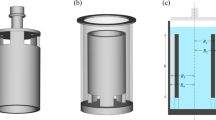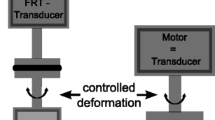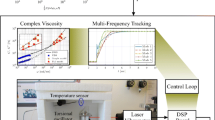Abstract
This paper is concerned with the effect of fluid inertia on experimental oscillatory stress data taken from a Controlled Stress Rheometer. A linear viscoelastic theory is developed which includes the effect of fluid inertia for cone and plate, parallel plate and concentric cylinder geometries. This theory is used to interpret dynamic data for both a slightly elastic and a highly viscoelastic fluid. It is shown that intertial effects are very small for both a cone and plate and parallel plate geometries. Inertial effects, however, can be important in the concentric cylinder geometry.
Similar content being viewed by others
References
Jones TER, Davies JM, Barnes HA (1984) In: Mena B, García-Rejón A, Rangel-Nafaile C (eds), Advances in Rheology, Universidad Nacional Autonoma de Mexico, Vol. 4: Applications, pp 45–52
Walters K (1975) Rheometry, Chapman & Hall, London
Walters K, Kemp RA (1968) Polymer Systems: Deformation and flow, Macmillan, London
Holder EF (1982) M.Sc Thesis, University of Wales
Author information
Authors and Affiliations
Rights and permissions
About this article
Cite this article
Jones, T.E.R., Davies, J.M. & Thomas, A. Fluid inertia effects on a Controlled Stress Rheometer in its oscillatory mode. Rheol Acta 26, 14–19 (1987). https://doi.org/10.1007/BF01332679
Received:
Issue Date:
DOI: https://doi.org/10.1007/BF01332679




